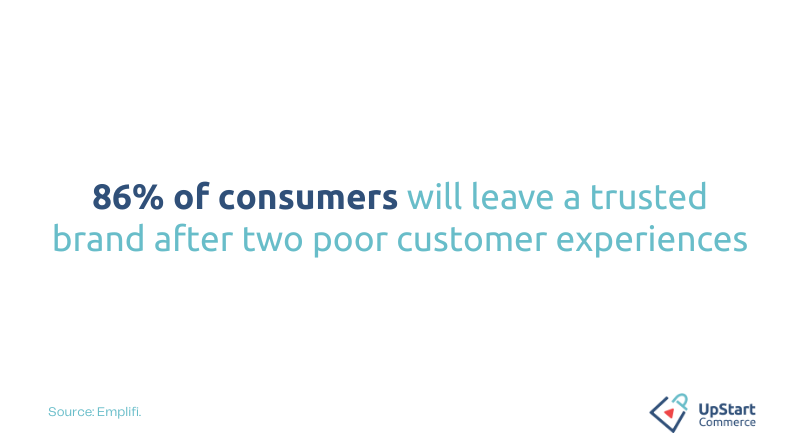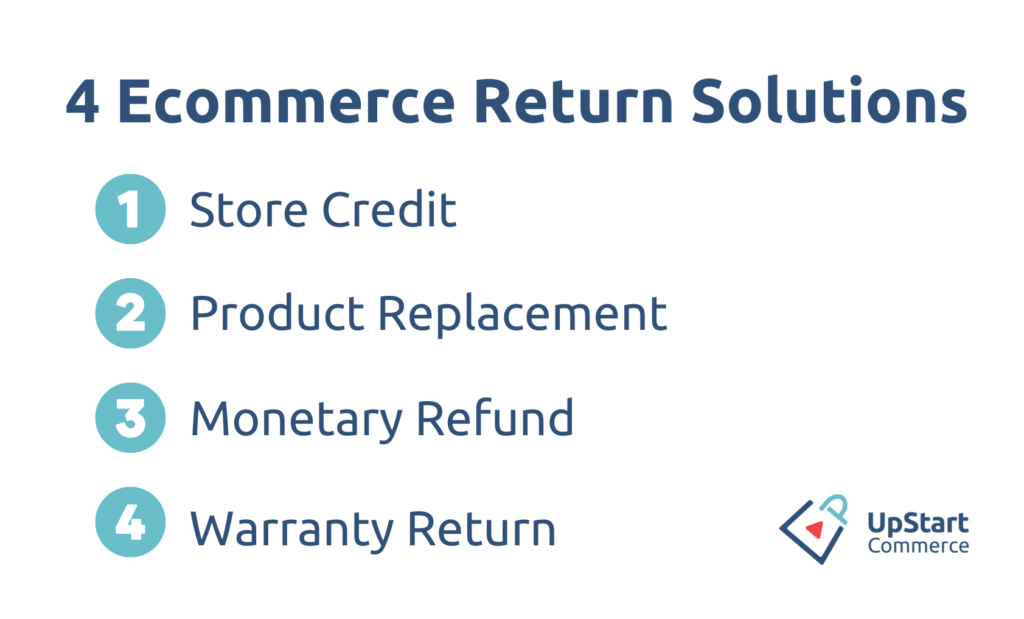Maintaining customer loyalty requires a positive customer experience. Customer experience begins with the consumer’s first interaction with your brand and extends through to the return process. According to Emplifi, an insight-providing platform, 86% of consumers leave a trusted brand after two poor customer experiences. Knowing how to handle customer returns is key to maintaining customer satisfaction during the return process. Improving ecommerce returns solutions can help retailers build trust with consumers, encourage customer loyalty, and streamline the ecommerce return process.

Types of Ecommerce Returns
To effectively address customer needs and improve the customer experience, retailers need to understand the reasons customers return their products and the differences between various types of returns. By doing so, retailers can offer solutions that lead to positive interactions and efficiently manage ecommerce returns.
Store Credit
Even when loyal customers are not satisfied with a product, they may be willing to give a brand a second chance. In these cases, providing store credit or points in exchange for returned products is a good solution. The points can be redeemed for purchases, discounts, or membership perks.
However, this type of return is not preferred by customers who expect compensation for their inconvenience. As a result, this ecommerce returns solution should be used sparingly and only for select customers.
Return for Replacement
In this type of ecommerce return, customers who are unhappy with their product can choose to replace it with a different version of the same product, such as a different color. Item replacements allow customers to select products of similar value from the ecommerce store as a replacement. These options allow customers to find a product that better meets their needs and preferences.
A report by IMRG, a UK-based ecommerce association, finds that customers expect a product replacement within 30 days. Managing ecommerce returns effectively maintains customer loyalty.
Monetary Refund
While refunds are the most common solution for returns, they can be costly for retailers and have a negative impact on company revenue. As an alternative, it is beneficial for retailers to offer replacements rather than issuing refunds. This can help to reduce lost revenue and maintain customer satisfaction.
Digital Commerce 360 concludes in a report that 77% of customers are less likely to recommend a brand if they take too long to refund their order. Refunding the customer at the expected time is essential to building customer loyalty in the long run.
Warranty Return
IBIS World, an industry research expert, concludes in a report that Product Warranty Insurance in the US Market Size reached $1.6 billion in 2022.
Many organizations do not categorize warranty returns as a type of ecommerce return, however, it is an important part of returns. It is important to handle warranty returns with the same care and attention as other return types. There are multiple types of warranties:
Service Agreement
In a service agreement, customers pay for product protection over an extended amount of time than the initial one provided by the manufacturer. Customers who purchase high-value items utilize this kind of warranty most often.
Third Party Warranty
If you place your products in a third party store then you can offer a Third-Party Warranty to your customers. In this type of warranty, retailers guarantee that they will repair or provide maintenance for a product even if it wasn’t bought from the brand.
Accidental Damage Handling Plan
Products that are damaged during the shipping process are protected under the Accidental Damage Handling (ADH) Plan. This gives customers confidence in placing high-value purchases from an ecommerce website, as it ensures that any damages or losses during shipping will be compensated.

Solutions That Improve The Return Process
Ecommerce returns are an unavoidable part of the retail industry. Soocial, a branding agency, shared that the average return rate for an ecommerce business is 18.1%.
However, there are solutions retailers use to improve their ecommerce returns process that increases customer loyalty and satisfaction. These solutions help minimize the negative impact of returns while improving the overall customer experience.
Here are strategies that improve the return process:
Returns Management System (RMS)
Returns Management System software allows retailers, online sellers, and manufacturers to manage and automate the returns process for products. According to The Insight Partners, a research report providing platform, the market size of the Product Returns Management Services industry increased by 5.1% in 2022. There are numerous benefits of implementing RMS within an ecommerce ecosystem.
Allow Customers to Manage Returns
Allowing customers to self-manage their ecommerce return establishes trust and builds brand loyalty. The software allows customers to efficiently handle the return process without the need for multiple emails, chatbots, or phone conversations, and that includes a tracking feature, Brands create a seamless and transparent experience for their customers by eliminating the need for multiple emails, chatbots, or phone conversations. Customers can use the platform to handle the return process on their own. Then, the tracking feature lets customers track the entire return process. This improves customer satisfaction and encourages brand loyalty.
Manage Conversions to Exchanges and Store Credits
Using the RMS, retailers can suggest items to exchange for unwanted products. This reduces the lost revenue for retailers. Apart from exchanges, RMS can display store credits a customer will receive after returning the product. These small steps can help maintain a positive relationship with customers.
Provide Valuable Data
Collecting data from customers regarding the reasons for their returns can help retailers identify trends and understand why certain products are being returned frequently. By analyzing this information, retailers can make improvements and informed decisions. This helps improve the overall customer experience and reduce the number of future returns.
Analyze Customer Reviews
Maintaining customer loyalty is essential for a brand’s long-term success. Including a comment section on pages where customers provide details about the products they return can help ecommerce retailers understand the customer’s reasons behind their choice to return a product, which can later lead to strategies that enhance the customer experience. Keep these things in mind when analyzing customer feedback:
Be Empathetic
It is important to maintain an empathetic attitude even if you disagree with the customer’s perspective or feel that the product is not at fault. Retailers who express understanding and willingness to help can show the customer their commitment to finding a resolution.
Create A Straightforward Process
To truly satisfy the customer, it is important to go above and beyond in the returns process. Make the process as simple and straightforward as possible, with minimal redundant steps, and offer multiple channels for customers to return products. This makes the process convenient for the customer and demonstrates a commitment to their satisfaction.
Make a Simple Return Policy
When creating a return policy, it is important to avoid using technical jargon that can be confusing to customers. Instead, keep the language simple, while also ensuring that the policy is clear and to the point. At the same time, close any potential loopholes that customers might try to exploit. A clear and fair policy fosters trust and confidence among customers.
Read “Ecommerce Solutions to Reduce Holiday Returns” to resolve the holiday returns issues.
Predictive Return Analysis
Deal News, a news-providing platform, found that an average American makes 8 returns per year. Returns can actually have a positive impact on sales and revenue. Customers who are satisfied with a brand’s return experience are more likely to make future purchases. Providing a great customer experience, optimizing costs, and ensuring that the revenue is maintained, allows retailers to leverage returns to drive sales and growth. Here is how:
Expect Returns
Being optimistic may work in other aspects of business, but when it comes to returns, it is important for retailers to be realistic. Retailers can analyze data to predict the likelihood of returns and prepare to handle them effectively. Having an effective strategy allows retailers to effectively manage returns and minimize their impact on the business.
Keep the Return Process Transparent
It is important to be transparent about all rules and regulations related to the return process to avoid frustrating customers. Retailers should disclose fees or charges upfront and not create any unexpected surprises at the end of the return process. Last minute changes can leave a negative impression and damage the customer’s trust.
Save the Sale
When dealing with returns, it is important to attempt to retain the customer and the sale. This can involve offering incentives, exchanges, store credit, or other solutions. Refunding the customer should be a last resort, as it reduces revenue and does not inherently encourage future purchases.
Increase Return Window
Science Daily, a science news provider, found that leniency in the length of the return window increases the total number of purchases a customer makes with an individual retailer.
Extending the return window gives customers more time to make decisions about their purchases. This provides a sense of security and gives customers the option to return a product even if they do not plan to use it for several weeks or months. Increasing the return window helps reduce the number of returns and improve customer satisfaction.
Conclusion
In conclusion, improving the ecommerce return experience increases customer satisfaction. Offering multiple return options, collecting data to understand customer needs and preferences, and being transparent and empathetic create a seamless and positive experience for customers. By taking these steps, retailers build trust and loyalty among customers to ultimately drive sales and growth for their business.
Want to seamlessly navigate ecommerce returns and build loyal customers? Connect with UpStart Commerce today to learn about our solutions that make the return processes easy.
